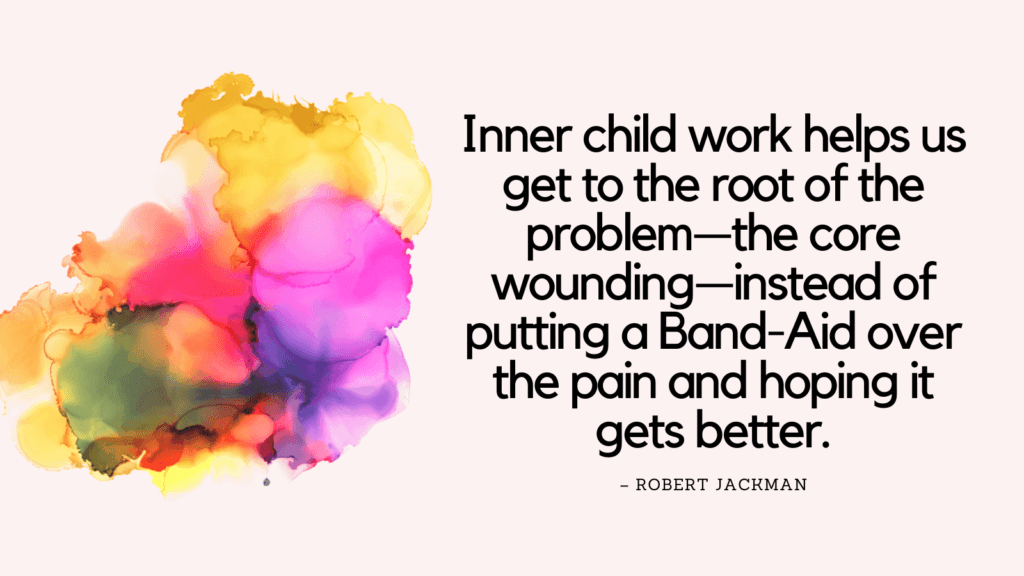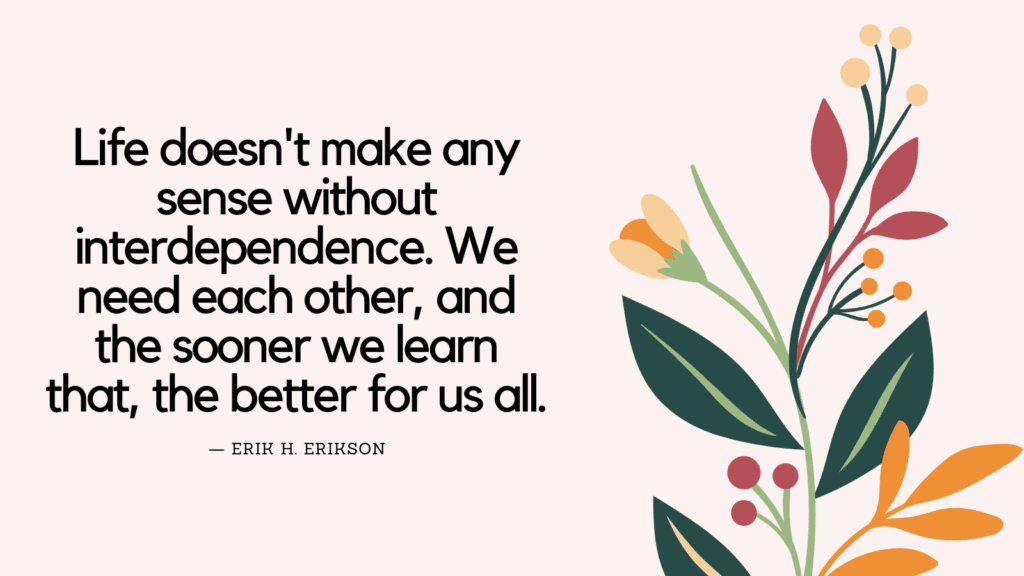This post contains some of the best inner child quotes.
What Is Inner Child?
The concept of the “inner child” refers to a psychological perspective that suggests we all carry within us a representation of our childhood experiences, emotions, and memories.
It is the part of ourselves that retains the thoughts, feelings, and beliefs we held as children. The inner child is often associated with our early developmental years, typically up until our teenage years.
This inner child aspect can influence our adult emotions, behaviors, relationships, and overall well-being.
Positive experiences from childhood can contribute to a healthy, confident, and resilient inner child.
However, if our childhood was marked by traumatic events, neglect, or emotional challenges, our inner child may carry unresolved pain, fears, or unmet needs that continue to affect us in adulthood.
Inner Child Quotes
1. “Becoming a loving Inner Adult/Parent to our Inner Child is the key to a productive and joyful life, as well as to the ability to establish and sustain intimacy.” – Margaret Paul
2. “Eventually the feelings of his Inner Child will find some kind of destructive release—addictions, stress-related illness, and so on.” – Margaret Paul
Related: Inner Teenager Healing: 14 Proven Exercises to Heal Your Inner Teenager
3. “Generally, in the absence of inner conflict between your rational and emotional aspects, your Adult feels “together,” with a sense of inner power for having taken responsibility and action. Your Inner Child feels free, safe, unguarded, and worthy.” – Margaret Paul
4. “Healing your lost inner child wounding takes time, gentle care, and learning to love and embrace your wounded parts.” – Robert Jackman
5. “If the Adult in us does not treat the Child in us lovingly, then telling the Inner Child he or she is lovable is just lip service and will create no real change in our present life.” – Margaret Paul
6. “Inner Bonding is a process of connecting our Adult thoughts with our instinctual gut feelings, the feelings of our “Inner Child,” so that we can live free of conflict within ourselves.” – Margaret Paul
7. “Inner Bonding is about giving ourselves, each and every moment, what we never had—or never learned—as children. It is about developing a loving relationship between our Adult and our Inner Child, a relationship that takes care of our Selves when we are around others and when we are alone.” – Margaret Paul
8. “Inner child work helps us get to the root of the problem—the core wounding—instead of putting a Band-Aid over the pain and hoping it gets better.” – Robert Jackman
Related: Best 10 Proven Ways to Heal From Childhood Trauma Splitting
9. “It is clear that we all do have an Inner Child. When people ask whether this can really be true, it usually reveals that they are not in touch with that soft and vulnerable part of their nature. When life is fairly easy and there are no major problems at hand, this lack of awareness is not a particular problem. But when there is conflict or a personal crisis and we feel unhappy or distressed, being out of touch or disconnected from our Inner Child can prevent us from restoring our emotional equilibrium.” – Margaret Paul
10. “It is not enough to tell the Child within that we love and cherish him or her, and that he or she did not cause our parents to be abusive. Unless we become the parents to ourselves that we always wanted, every moment of the day, our Inner Child will never believe he or she is really lovable.” – Margaret Paul
11. “It’s very important to realize that the inner child is still there, caught in the past. We have to rescue him.” – Thich Nhat Nanh
12. “Many people don’t realize that they have a lost inner child who makes a lot of decisions in their adult life that the responsible adult self later has to clean up. They go about their lives on auto-pilot, impulsively reacting, yelling at the top of their lungs, withdrawing and sulking, or keeping others at arm’s length because they are scared of emotional connection. They feel hurt, confused, abused, shamed, or neglected, just like they did as a child, but now they look and sound like an adult. They are unaware that a part of them is lost and emotionally stuck in place. Many people are scared to look within because they know at some level that something powerful is lurking in the shadows, carrying all of those feelings they want to avoid.” – Robert Jackman
Related: Top 25 Inner Child Journal Prompts To Heal Your Inner Wounds
13. “One of the main reasons we avoid our inner child is because we’re afraid of suffering.” – Thich Nhat Nanh
14. “Our Inner Child, however, is childlike—our vulnerability, intuitiveness, sense of wonder, imagination, innate wisdom, and ability to feel our feelings have not changed or aged with our growing, adult experience. Thus, while many of us had very unhappy childhoods, that doesn’t mean our inner nature is essentially unhappy.” – Margaret Paul
15. “The inner child is as real as the grown up adult. It’s like the seed of corn is still real in the plant of corn. It’s there; it’s not only a matter of the past. So if the plant of corn knows that she is one with the grain of corn, conversation is possible.” – Thich Nhat Nanh

16. “The Inner Child is the aspect of our personality that is soft, vulnerable, and feelings-oriented—our “gut” instinct. It is who we are when we were born, our core self, our natural personality, with all its talent, instinct, intuition, and emotion.” – Margaret Paul
17. “The lost inner child is a part of you that is emotionally frozen in time. It is “lost” in the sense that you may be oblivious to what will later be obvious signs of communication from this part. Even though this is a part of you, it is lost because it didn’t mature emotionally with the rest of you.” – Robert Jackman
18. “The narcissistically deprived inner child contaminates the adult with an insatiable craving for love, attention, and affection. The child’s demands will sabotage his adult relationships, because no matter how much love is forthcoming, it’s never enough.” – John Bradshaw
Related: Inner Child Wounds Test (+4 Attachment Imagery Exercises To Heal Inner Child Wounds)
19. “We tend to think that all people who have a wounded inner child are nice, quiet, and long-suffering. But in fact, the wounded inner child is responsible for much of the violence and cruelty in the world.” – John Bradshaw
20. “When the lost inner child who doesn’t have good boundaries reacts impulsively to a situation or event, the responsible adult self has to negotiate and manage the drama the wounded part creates. This lack of boundary setting creates a lot of confusion, and we can get lost in these dramas and in the loudness of our wounded parts.” – Robert Jackman
21. “When we are being loving to our Inner Child, we are open to learning about our Child and from our Child. Loving our Child means choosing to learn about ourselves—our past and present pain, fears, and beliefs.” – Margaret Paul
22. “When you abandon your Inner Child, you don’t take action to help yourself. Not taking action is avoiding responsibility.” – Margaret Paul
23. “When you choose to disconnect from your feelings, you abandon your Inner Child through being authoritarian (critical, discounting, shaming) or permissive (ignoring, indulging) with your Inner Child.” – Margaret Paul
24. “Your core wounding, your lost inner child, is indirectly asking to be healed so that all of you can move on and become fully integrated.” – Robert Jackman
25. “Your inner child and you aren’t exactly two, but you aren’t exactly one either. You influence each other. As adults we can practice mindfulness and invite the inner child to join us in the practice.” – Thich Nhat Nanh
Related: Best 15 Inner Child Exercises: How To Connect With Your Inner Child (& Heal Your Childhood Wounds)
Inner Child Healing Exercises PDF
Conclusion
Understanding and connecting with our inner child can be a helpful therapeutic approach for healing emotional wounds and promoting personal growth.
It involves acknowledging and validating the experiences and emotions of our younger selves, providing comfort, nurturing, and compassion to those parts of us that may still feel hurt or unresolved.
This process allows us to integrate our past experiences into our present self, fostering greater self-awareness, acceptance, and emotional well-being.
Engaging in activities such as visualization exercises, journaling, inner child therapy, or working with a therapist who specializes in inner child work can help individuals explore and heal their inner child.
References
- Portions of this article were adapted from the book Inner Bonding, © 1992 by Margaret Paul. All rights reserved.
- Portions of this article were adapted from the book Healing Your Lost Inner Child, © 2020 by Robert Jackman. All rights reserved.



